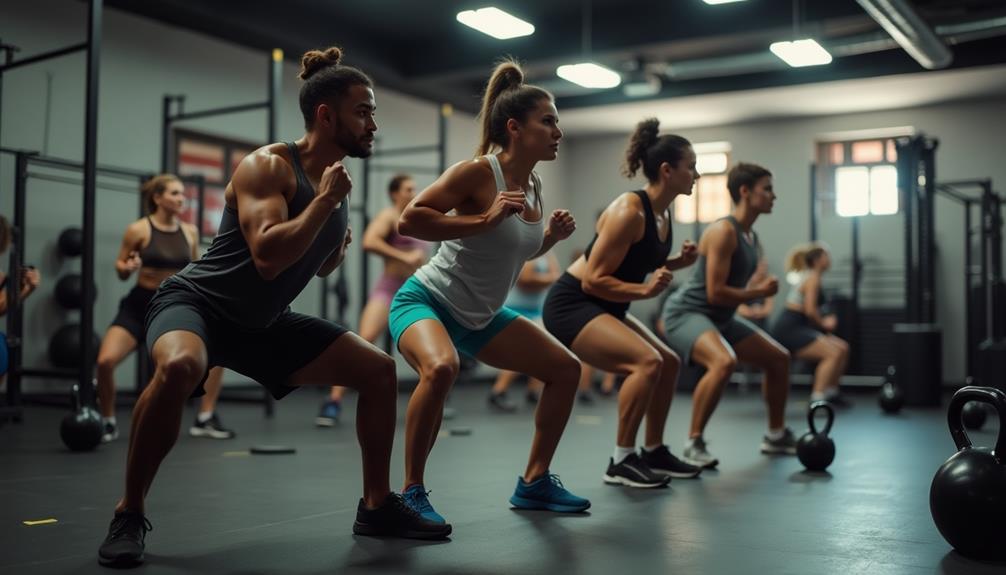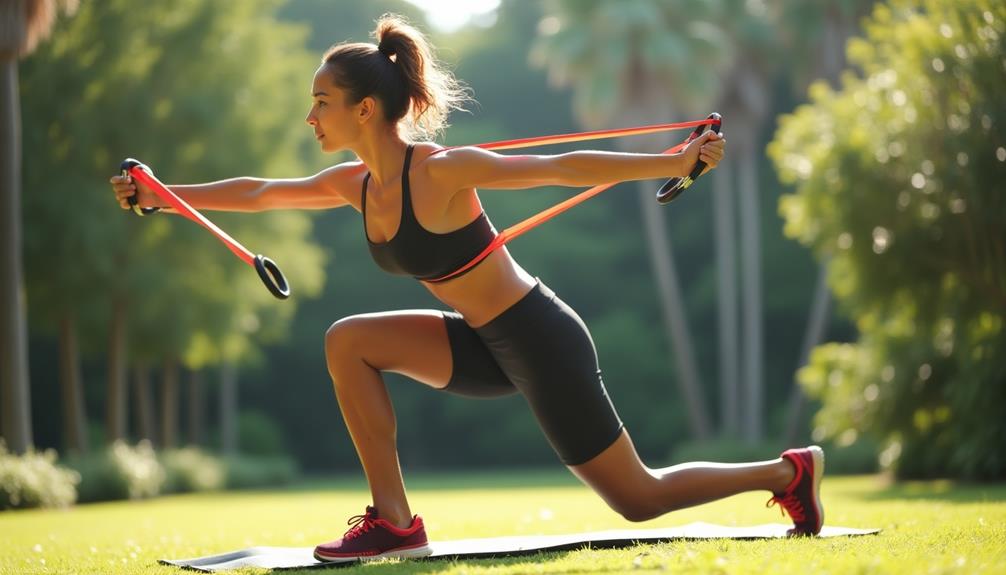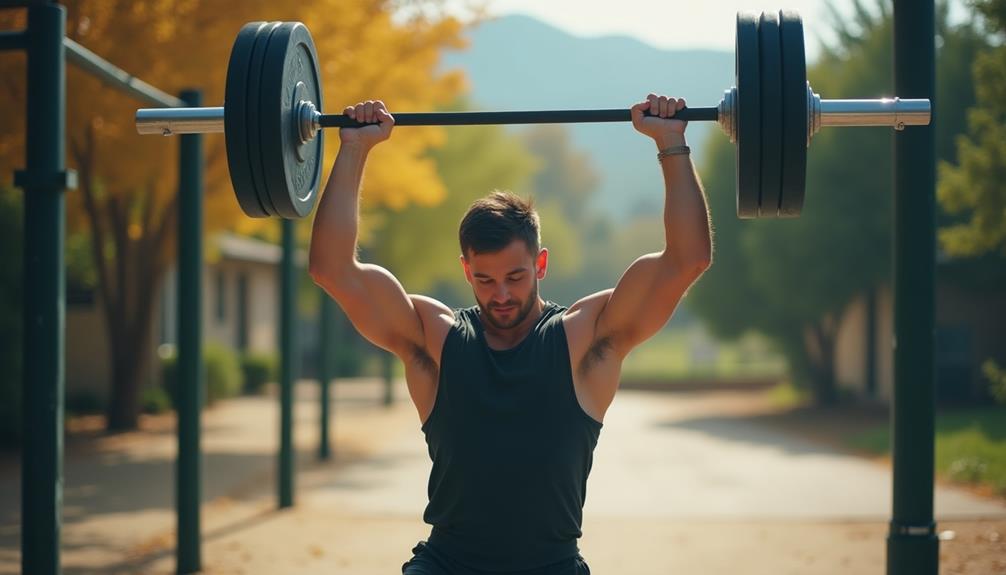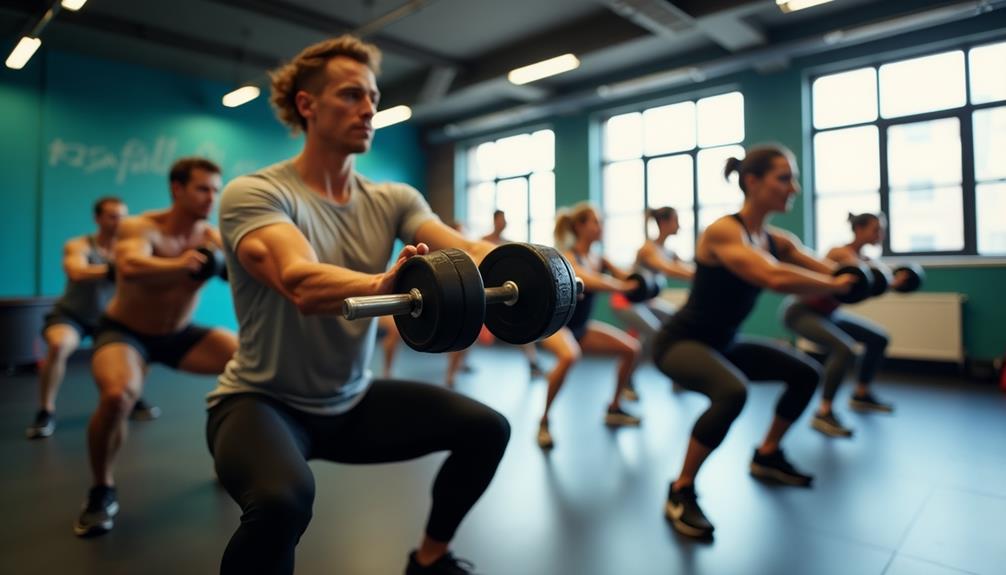Loaded Movement Training (LMT) enhances your physical performance by incorporating external weights into everyday movements. It emphasizes practical exercises that mimic real-life tasks, using tools like dumbbells, kettlebells, or resistance bands. This method boosts strength, stability, and coordination. LMT activates multiple muscle groups, increasing calorie burn and promoting better balance and endurance while reducing injury risk. To start, choose a safe space, begin with manageable weights, and focus on form. You'll find exercises like goblet squats and deadlifts beneficial. If you're curious about specific techniques and tips for maximizing your training, you're in the right place for more insights.
Core Insights
- Loaded Movement Training (LMT) enhances physical performance by incorporating external weights in movements that mimic real-life tasks.
- LMT improves strength, stability, and coordination by engaging multiple muscle groups through dynamic movements.
- Core engagement in LMT helps stabilize the body, enhancing performance and reducing injury risk.
- LMT promotes endurance and power while increasing calorie burn and workout efficiency.
- Common exercises include weighted carries, goblet squats, deadlifts, and overhead presses, targeting various muscle groups.
Understanding Loaded Movement Training

Loaded movement training focuses on enhancing your physical performance through the intentional use of external weights. This method emphasizes movements that mimic real-life tasks, making it functional and practical. You incorporate weights like dumbbells, kettlebells, or resistance bands into your workouts, which challenges your muscles more than bodyweight exercises alone. Resistance tubes offer a versatile option for loaded movement training, with various resistance levels available to suit different fitness goals and exercises. As you engage in loaded movements, you'll notice improvements in strength, stability, and coordination. It's not just about lifting heavy; it's about moving effectively in various planes of motion. By applying external resistance, you develop a better understanding of body mechanics, which can translate into better athletic performance and daily activities. Overall, loaded movement training is a versatile approach to improving your physical capabilities and enhancing overall fitness.
Key Principles of LMT

Focusing on the foundational elements of loaded movement training (LMT) can greatly enhance your workouts. Understanding these key principles will help you apply LMT effectively.
| Principle | Description |
|---|---|
| Load Variation | Adjusting weights and resistance helps adapt your body. |
| Movement Patterns | Incorporating fundamental movement patterns promotes functional strength. |
| Core Engagement | Engaging your core stabilizes your body and enhances performance. |
Benefits of Loaded Movement Training

When it comes to enhancing your fitness routine, the benefits of loaded movement training (LMT) are hard to ignore. LMT integrates resistance with dynamic movements, improving strength and stability. As you perform functional exercises, you'll activate multiple muscle groups, leading to greater overall strength gains. Similar to compression sleeves for recovery, LMT can help reduce the risk of injury and enhance performance in various activities.
Another advantage is increased calorie burn. By incorporating weights, your body works harder, making workouts more efficient. LMT also enhances coordination and balance, which are essential for daily activities.
Moreover, this training method promotes joint health, reducing injury risk through improved stability and muscle support. You'll notice better performance in sports and other physical activities, as LMT builds endurance and power. Overall, LMT offers a thorough approach to fitness that can transform your routine.
How to Get Started

Getting started with loaded movement training (LMT) is easier than you might think. You don't need fancy equipment or a personal trainer. For best results, consider incorporating functional training tools like medicine balls into your routine. These versatile implements can enhance your LMT workouts and target multiple muscle groups simultaneously. Here are some simple steps to help you begin:
- Choose a safe space: Find an area where you can move freely.
- Start light: Begin with manageable weights or even just your body weight to master the movements.
- Focus on form: Prioritize proper technique over lifting heavy to avoid injuries.
- Set goals: Define what you want to achieve, whether it's strength, mobility, or overall fitness.
Common Exercises in LMT

After you've set up your space and established your goals, it's time to explore some common exercises in loaded movement training (LMT) that can enhance your strength and mobility.
1. Weighted Carries: This exercise involves carrying a weight, like a kettlebell or dumbbell, while walking. It improves grip strength and core stability.
2. Goblet Squats: Holding a weight at chest level, squatting down engages your lower body and promotes proper form.
3. Deadlifts: This fundamental move works multiple muscle groups. Use a barbell or kettlebell for added resistance.
4. Overhead Press: Lifting weights overhead builds shoulder strength and stability.
Incorporating these exercises into your routine can lead to significant improvements in functional strength and overall fitness.
Comparing LMT to Traditional Training

Loaded movement training (LMT) offers a unique approach compared to traditional training methods. While traditional training often focuses on isolated movements, LMT emphasizes functional, multi-directional movements that mimic real-life activities. This shift in focus can lead to various benefits, including:
- Improved overall strength and stability
- Enhanced coordination and balance
- Greater functional fitness for daily activities
- Reduced risk of injury through better movement patterns
LMT blends strength training with dynamic movement, making your workouts more engaging and applicable to everyday life. You'll find that LMT encourages you to use your body as a whole, fostering a deeper understanding of movement mechanics. This holistic approach sets it apart from conventional methods, making it a valuable addition to your fitness routine.
Who Can Benefit From LMT

Many individuals can reap the rewards of loaded movement training (LMT), regardless of their fitness level or goals. Beginners can build a solid foundation, improving their strength and stability. For those with specific athletic aims, LMT can enhance performance by mimicking real-life movements. If you're recovering from an injury, LMT offers a safe way to regain strength while focusing on proper movement patterns. Even seasoned athletes can benefit, as LMT challenges the body in new ways, promoting functional strength. Additionally, older adults may find LMT helpful for maintaining mobility and independence. Ultimately, whether you're just starting out, rehabbing, or looking to up your game, LMT can be tailored to meet your unique needs and aspirations.
Tips for Success in LMT

To succeed in loaded movement training (LMT), initiating with a clear plan and setting realistic goals is crucial. Here are a few tips to assist you on your journey:
- Focus on form: Prioritize correct technique to prevent injuries.
- Gradually increase load: Begin with lighter weights and gradually increase to build strength safely.
- Incorporate variety: Integrate diverse movements to engage different muscle groups and prevent plateaus.
- Listen to your body: Be mindful of your body's signals and adapt your training as needed.
Frequently Asked Questions
Is Loaded Movement Training Suitable for Beginners?
Yes, loaded movement training can be suitable for beginners. It builds strength and improves mobility, but you should start with lighter weights and focus on form to prevent injury. Gradually increase intensity as you progress.
How Often Should I Practice Loaded Movement Training?
Think of your body as a blossoming flower; practice loaded movement training two to three times a week. This frequency nurtures growth and strength, allowing you to flourish without overwhelming your petals. Balance is key!
Can I Combine LMT With Other Workout Styles?
Yes, you can definitely combine LMT with other workout styles! Mixing in strength training, cardio, or flexibility exercises can enhance your overall fitness. Just make sure you balance intensity and recovery to avoid overtraining.
What Equipment Do I Need for Loaded Movement Training?
You'll need minimal equipment for loaded movement training. A barbell, dumbbells, kettlebells, or resistance bands work well. Also, consider a sturdy mat for comfort during floor exercises. Keep it versatile to enhance your workout experience!
Are There Any Risks or Injuries Associated With LMT?
Imagine crossing a rickety bridge; you need caution. While you're exploring new training methods, risks like strains or overexertion can creep in. Always listen to your body, and take it slow to avoid injury.

